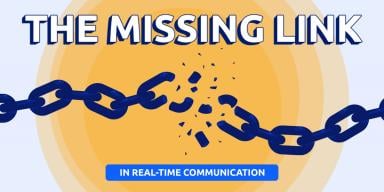![A Complete 17-Step Guide to a Successful Capital Campaign [with Benefits, Risks, and Examples] A Complete 17-Step Guide to a Successful Capital Campaign [with Benefits, Risks, and Examples]](/sites/default/files/image_1597.png)
Nonprofits have ongoing financial needs for their escalating projects. Whether it’s a new building, renovation, or starting a new service, they need large donations to expand their operations.
While annual fundraising efforts provide nonprofits with necessary funds to carry out their daily operations, they may not be sufficient for investing in large-scale projects. In this case, a capital campaign is an optimal approach to collect large donation amounts.
In this comprehensive guide, we will walk you through all the necessary steps to make your fundraising successful. You can also find benefits, risks, and real-world examples for a thorough understanding.
Read the entire guide if you are a beginner or skip to your desired section for a detailed explanation.
Quick Reads
- What Is a Capital Campaign?
- What Are Capital Campaigns For?
- Benefits of a Capital Campaign
- Risks of a Capital Campaign
- 17-Step Guide for Getting Started with a Capital Campaign
- Real-World Examples of Successful Capital Campaigns
What Is a Capital Campaign?
Simply defined, a capital campaign is a systematic approach to raising money for a particular nonprofit project. It is different from the other fundraising efforts as it has:
- A concrete goal (usually large-scale projects)
- A targeted fundraising amount
- A realistic timeline with phases (up to five years)
Since capital campaigns are extensive fundraising efforts for large projects, they need a robust team and community support. They are unlikely to succeed without the cooperation of board members, staff, and individuals.
Timeline of a Capital Campaign (Phases and Duration)
To organize a winning campaign, you must know when and what to do.
Once you divide your campaign into phases, you can easily decide the duration and budget required for each one.
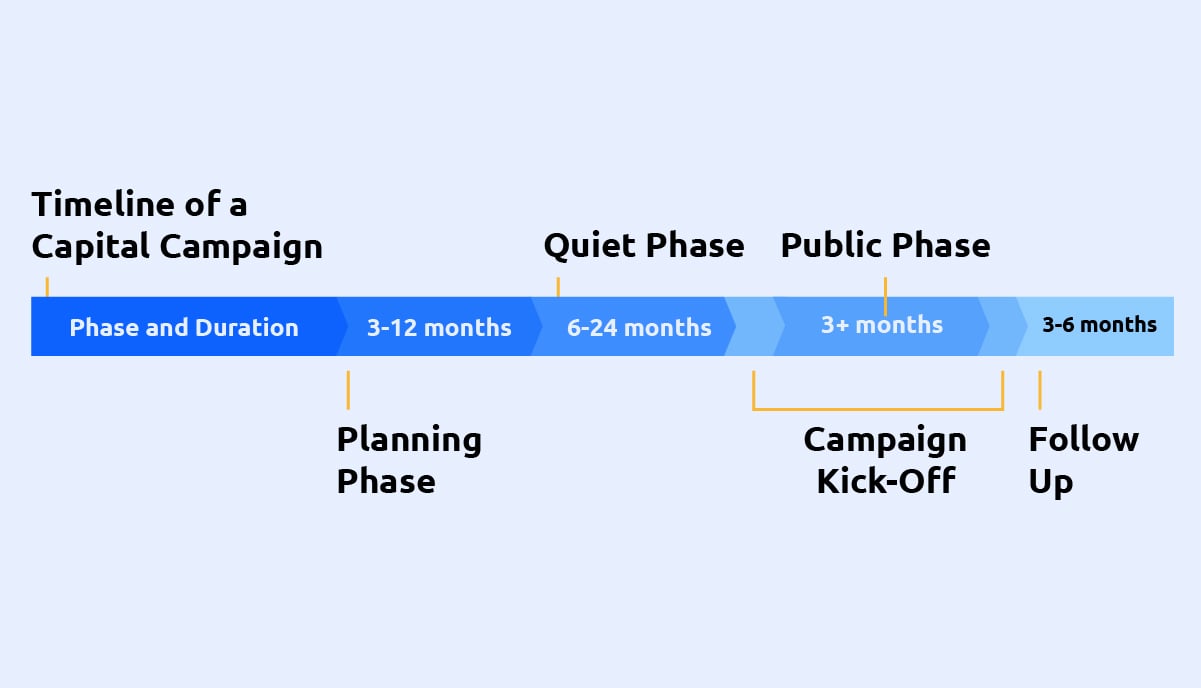
Planning Phase (3-12 Months)
Planning is a crucial phase for your entire campaign as it lays the entire foundation of your next-level plans. How well you strategize during this phase will dictate the success of your campaign.
During a planning phase, you define your fundraising goals, conduct a feasibility study and present your case to your stakeholders.
Quiet Phase (6 to 24 Months)
Phase 2 is where your campaign gets started. However, you don't make it public yet. Instead, you ask your key sponsors for large donations.
The quiet phase strictly operates on network building, where one sponsor leads you to the next. The goal of this phase is to collect a large sum of money from wealthy donors. Once you get your major contributors, they can connect you to other mid-level prospects.
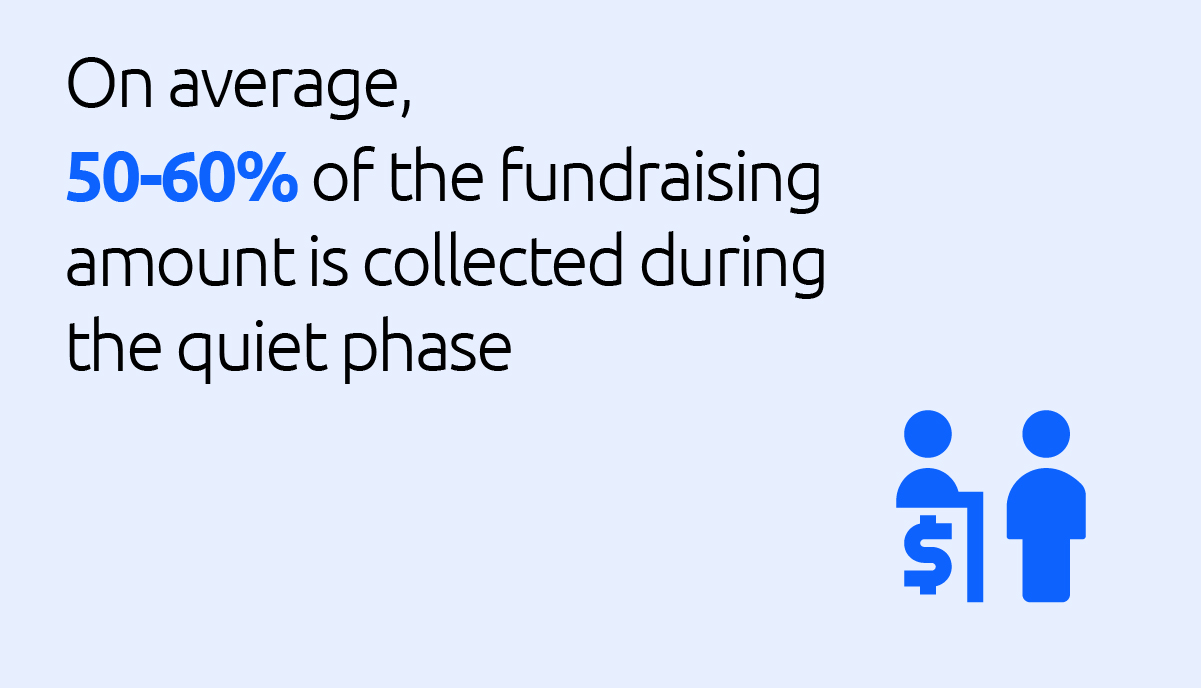
On average, you can expect to earn 50 to 70% of your fundraising amount during the quiet phase.
Campaign Kick-off (When More Than 60% Of the Funds Are Received)
Campaign Kick-off is the main event that transitions you from the quiet to the public phase. Kick-offs only happen when you have generated more than 60% of the money from major gift donors, and are ready to collect the rest of the funds from sporadic or one-time donors.
The campaign is made public via website posts, events, or press releases. You can also distribute brochures or make official announcements on your social media account. Publicizing your progress at this stage attracts new donors to receive the remaining funds.
Public Phase (Around 3 Months)
The kickoff phase is followed by a public phase where new donors are sought. You can try different fundraising strategies (both online and offline) to reach your target prospects. You can make social media announcements, plan activities and create volunteering opportunities to create excitement and engagement among the audience.
Follow Up (3-6 Months)
Once you have reached your fundraising goal, it is now time to acknowledge everyone who contributed.
Send thank you emails to your donors, print certificates for your volunteers, and call your sponsors personally to show appreciation. You can also create an online member directory and send out automated emails to them.
You may also check your campaign results to determine which areas need to be improved. This will help you make your upcoming campaigns more effective with enhanced results.
What Are Capital Campaigns For?
Non-profits launch capital campaigns to get funding for their large-scale projects, such as:
1. Buying New Equipment
NPOs are always in need of new supplies and equipment. But you don't need a capital campaign for every one of them.
Typically, fundraising campaigns are organized for large-scale purchases such as radiology machines for hospitals or electron microscopes for schools.
2. Initiating a New Program or Service
Funding for a new program or service is another great reason to run a capital fundraising campaign.
Let's say, you are an educational institution planning to introduce a new degree program. It requires a lot of money to set up classes, buy equipment, and hire professors.
With a fundraising campaign, your message will reach the donors and you'll receive the funds you need to start the program.
3. Expanding the Existing Space
Charity organizations often run out of space as they grow.
It doesn't matter what kind of institution you are running, whether it is a school, a hospital, or an animal shelter. As you level up, you need more space to accommodate the growing population of your organization.
In such cases, expanding the existing space is a great option but will require financial support from the donors through fundraising campaigns.
4. Moving to a Larger Location
There are times when expanding the existing space is not feasible. So you decide to move to another location to accommodate the growing needs of your community. Additionally, organizations sometimes buy new lands for future expansions.
No matter what the case is, purchasing a building is an extremely high-end investment and will require funding. With a capital campaign, you can raise money to acquire new assets for your facility.
Benefits of a Capital Campaign
A capital campaign has its obvious goal i.e. funding a new building or investing in a new project. However, it can build a well-reputed profile for your agency when executed well.

In addition to collecting the fundraising amount, a capital campaign can benefit your organization in many ways, including:
- Increasing your organization's visibility in terms of its goals, missions, and upcoming projects.
- Collecting money from a large audience, boosting your annual funding capacity.
- Bringing all team members, sponsors, and volunteers on board, increasing their involvement and participation.
While these are obvious, a comprehensive capital campaign can level up your organization by building partnership opportunities.
A strong campaign message can reignite the social responsibility of a donor, urging them to invest in your new project. These corporate partnerships are great to fund your current and upcoming programs, donate gifts and build more networks for you.
Risks of a Capital Campaign
Risks and rewards go hand in hand when it comes to capital fundraising. However, that shouldn't deter you from taking the initiative. A well-planned campaign can yield successful results considering that you avoid the following risks:
- Excessive Spending: A fundraising campaign comes with large expenses required for advertising, conducting feasibility studies, and paying employees. As a rule of thumb, you should not spend more than 15% of your fundraising goal. If you don’t track your expenses efficiently, chances are that you might exhaust your organization’s finances.
- Decrease in Annual Funding: There's a chance that your annual fundraising will be reduced in the years you are running a capital campaign. For instance, if you ask donors to fund a new endeavor, they may deter you from contributing to your current projects for the year, negatively impacting your cash flow.
- Risk of Overadvertising: You may over-advertise your new program and set up high expectations for the donors. Failure to meet these expectations will ruin your organization's reputation. Worse, certain donors may cease to sponsor you.
- Employee Burnout: The risk of burnout is higher when employees work too hard to achieve the campaign goal. A study suggests that high levels of emotional engagement lead to burnout, resulting in high turnover rates. Considering the engaging nature of capital campaigns, employees actively involved can suffer emotional and mental fatigue.
17-Step Guide for Getting Started with a Capital Campaign
Now that you have all the information you need for a capital campaign, browse this step-by-step guide on how to get started with one.

1. Begin With Reviewing Your Past Fundraising Results
Your fundraising goal cannot be achieved until you review and improve past campaign results.
Knowing your past performance will allow you to identify the areas where you lacked, what efforts went down the drain, and where your finances suffered. Thus giving a clear image of how you can improve this time around.
Essentially, the review of your past fundraising efforts should take the following points into account:
- Was your fundraising goal achieved in the designed time?
- Who were your major gift donors? Are they still funding your organization?
- Was the annual fundraising improved after the campaign?
- Did the team exceed the budget?
For instance, improved financial data following fundraising may indicate that your strategy worked. Conversely, a decline in donations indicates that your campaigns were not effective enough.
2. Establish a Capital Campaign Committee
A capital campaign can’t succeed if one person is making all the decisions. It is a team project that involves directors, employees, volunteers, and sponsors.
Choose your board members wisely as they will represent your organization at all important meetings and events. Ensure they are well connected with sponsors, government agencies, and government personnel to reach as many people as possible with your fundraising mission.
Next, establish a team of staff members for your capital campaign. You can either recruit volunteers online or post banners. If necessary, hire employees on a contractual basis so they can fully devote themselves to the project.
Lastly, involve major sponsors of your organization in your project to understand their perspectives as donors. You can use their suggestion to leverage your campaign to attract more prospects for endowments.
3. Conduct a Feasibility Study for Your Campaign
A feasibility study is like product testing for your capital campaign. It helps to determine if your campaign will reach its goal and whether it will receive sufficient responses from donors.

During a feasibility study, you interview 20 to 30 stakeholders and ask them questions like:
- What do you think about the project?
- Do you think we will achieve the goals within the set time frame?
- How much funding will the project receive in your opinion?
Lastly, you can ask them for suggestions for improvements. After your feasibility study is completed, you will better understand your campaign and what changes should be made.
4. Find Prospects for Your Campaign
You will have to find lead donors to make your campaigns successful. In addition to contributing to your fundraising efforts, lead prospects will also introduce you to other potential donors.
Starting with your current sponsors is a good place to start. Since they already know and trust your organization, they can be an invaluable fundraising partner. Next, contact donors who contributed previously to your fundraising efforts. You can also try donation software to find new prospects.
You can also conduct a wealth screening test to find your major gift donors. The test predicts the likelihood of a prospect to donate based on the following two factors:
- Willingness to donate
- Ability to donate
Having someone who meets both of those criteria means you have a major prospect for your fundraising campaign.
5. Set a Realistic Deadline For the Campaign
A campaign can take anywhere from 1 to 5 years to reach the fundraising goal, depending on the scope of the project. Thus, having a clear, realistic timeline can help you plan and execute your campaigns effectively.
Don't make your plan too focused on one target date. Allow for unexpected events that might hamper fundraising. Choose a deadline that corresponds to how long you expect to collect the fundraising amount.
For example, you should not let your campaign drag on in case of potential roadblocks. This might be an indication to reevaluate, and not spend any more time on a campaign that is unlikely to succeed. On the other hand, don’t stop your fundraising efforts if you reach your goals near the planned deadline.
6. Finalize Your Fundraising Goal
The fundraising goal may not always correspond to the expense of starting a project, as there are several other hidden costs.
Employee fees, attrition costs resulting from turnover, advertising, and subscription fees for online platforms are all examples of the added expenses. Thus, many organizations are surprised to discover that raising funds is itself a costly procedure.
One way to combat this is to include the additional cost in your fundraising goal. You should also consider inflation when deciding your fundraising goal since it will also increase your expenses. However, don't stray too far from the original quote, as sponsors may ask questions about each addition.
7. Hire a Consultant to Lead the Campaign
Hiring consultants may seem like an extra expense in your campaign, but they can speed up your fundraising process. A fundraising specialist will take charge of your campaign from the feasibility study till you reach your final goal.
Capital campaign consultants are not just involved in helping you reach fundraising goals. By partnering with a consulting firm, you will be able to build a professional network and find new prospects. As a result, a consultant will benefit your organization in the long run.
Consultant fees vary widely depending on the scope of the project. Typically, a consultant will charge around $30,000 per month for grand projects. However, you can choose to pay them upfront for the entire project or set up a fixed payment monthly or yearly. For simple projects that don't take much time, consultants may also prefer hourly payments.
8. Decide the Budget for Your Campaign
As mentioned previously, your budget should not exceed more than 15% of your fundraising goal. However, it is common for organizations to spend beyond their intended budget.
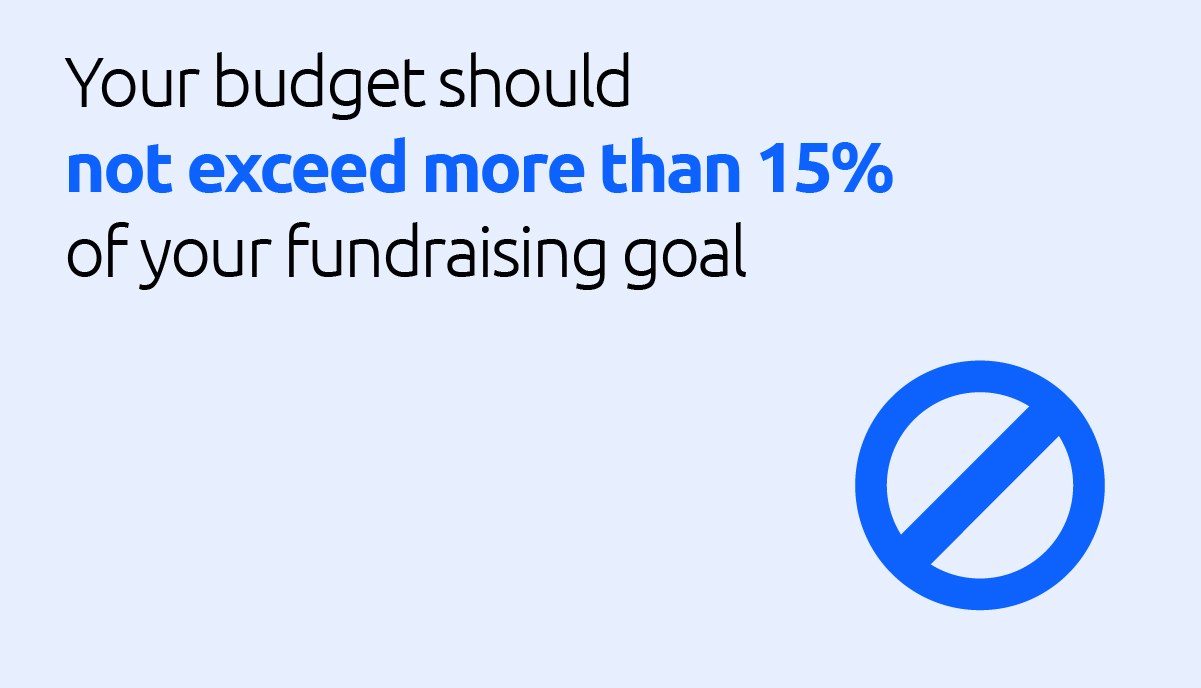
An important reason for increased spending is the indirect costs associated with campaigns that weren't included in the budget early in the process. Thus, you must fine-tune your budget with both obvious and hidden costs in mind.
Direct costs include consultant fees, employee salaries, and feasibility study fees. Alternatively, indirect costs include expenses associated with brochures and prospectuses, promotional videos, and phone calls and meetings with donors.
9. Create Backup Plans to Combat Campaign Disasters
Whether it's a business or an NPO, backup plans are vital to combat any kind of disaster. The events can vary from small administrative glitches to major operation failures that can delay your project for several months.
The best you can do in planning and implementing your capital campaign is to anticipate issues that may arise. Make sure that your subgroups stay in regular contact with the mainboard to spot problems as soon as they happen. In this way, you will already be prepared for any mishap that can happen during your campaign.
10. Create a Donation Pyramid for the Campaign
Once you are done with setting up your goals and budget, you will need to create a donation pyramid for your campaign. The donation chart is a pyramid indicating that a large sum of money is collected from major donors.
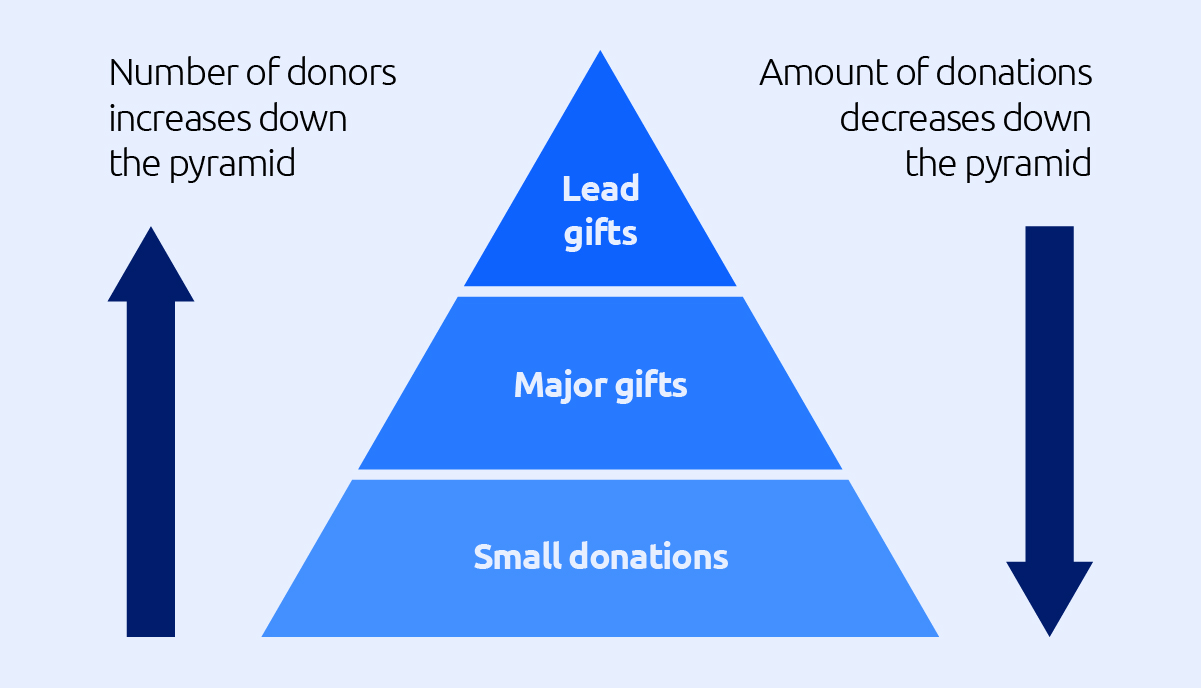
The gift (donation) chart shows the following sum:
- 60% of fundraising amount from major sponsors (around 6-8)
- 20% of the goal received from moderate supporters (around dozen)
- 10% amount raised from small donors (hundreds)
Each type of fundraising campaign will have its gift chart. For instance, a capital campaign for a building will have more sponsors at the top of the chart as compared to a campaign for purchasing equipment.
You can ask your consultant to project your gift chart or use a gift chart calculator. This will help you determine how many donors you need at each funding level.
11. Develop a Plan for Achieving Your Fundraising Goal
Having your gift chart ready will give you a clearer idea of how much each level of donor contribution will contribute.
Now you need to create a plan to get donations from prospects. You will need to plan how to acquire major donations, announce your campaign launch, and use marketing tactics to acquire the remaining funding.
Establish milestones for evaluating your fundraising efforts. When your benchmarks aren't being met consistently, that may indicate that your fundraising goal isn't reachable and you need to readjust your plans.
12. Draft the Roadmap for Your Campaign
As mentioned earlier, a timeline for a capital campaign can range anywhere between 1 to 5 years. Depending on the scope of your project and fundraising goal, you can decide how long each phase will last.
For example, you may decide that your quiet phase will be longer than 24 months to collect the large donations from key sponsors. Alternatively, if you reach your kick-off amount earlier you can extend the duration of the public phase.
All in all, your timeline will reflect your project, fundraising amount, gift chart, and budget of your campaign.
13. Prepare the Advertising Material for Your Campaign
Now that the entire campaign is planned, it is time to start preparing the advertising material. The outreach will include online and offline materials such as brochures, posts, emails, newsletters, and pledge cards to ensure that everyone is covered.
Ensure that the material you use corresponds to the prospects you will meet during each phase. As an example, during the quiet phase, you will reach out to key sponsors, requiring detailed materials to make informed decisions. The paperwork at this stage should be detailed, explaining your goals, budget, and timeline to persuade them to donate.
In contrast, advertising for the public phase will be more emotional (such as sentimental social media posts) to attract a large number of prospects for small donations.
You can ensure a positive impression of your organization and capital campaign by having these support documents available before you even begin soliciting donations.
14. Draft Your Case Statement for the Campaign
Case statements are used during capital fundraising to appeal to your prospects for donations. This document explains your project and the mission of fundraising, as well as why anyone should contribute.
The size of your case statement depends on the size of your organization and project. One draft will be needed for a small project (such as equipment purchase), while several drafts will be required for a donation.
Make sure your case statement is professional, visually appealing, and informative. Describe what your organization has accomplished in the past and why you need money to move forward. The bulk of your marketing materials will be built upon this one document.
15. Periodically Follow Up During Phases
Once all the operations are in a streamline, it's time to follow up after regular intervals. Hold team meetings at regular intervals to know your progress regarding:
- The ongoing efforts to meet and convince major gift donors
- The update of the kick-off events
- The marketing materials for the public phase
It is possible to keep your timeline flexible. Keep all team members in the loop by including them. You can change your original plan if necessary, such as adding virtual events for more sponsorships.
16. Build Meaningful Partnerships With Lead Sponsors
The key to your long-term success is developing meaningful relationships with your major donors.
Nonprofits often neglect relationship management, instead of relying too heavily on social media advertising and e-mail marketing to raise money. In reality, the major chunk of your gift chart comes from connections acquired by network building.
In addition, they will help you receive funding for your upcoming projects as well as increase your yearly funding.
17. Make the Most of Your Capital Campaign With Glue Up Software
A Capital Campaign is a multi-step approach with several tasks in hand. To make sure that you don't miss out on important things, you can make your tasks aligned with a proper fundraising platform.
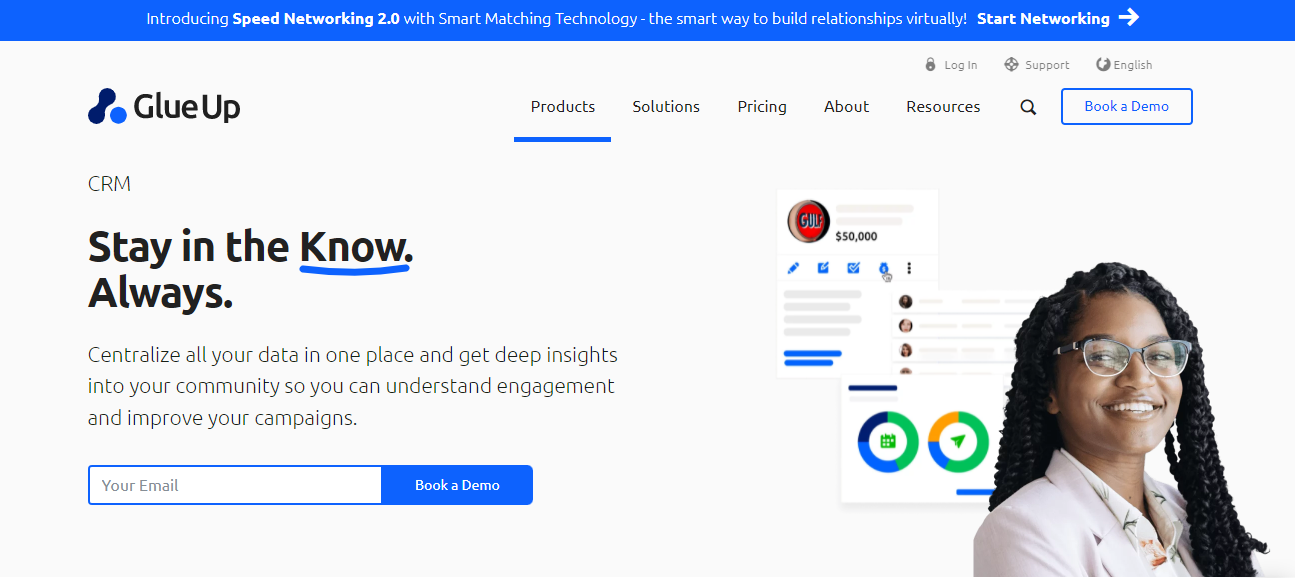
Glue Up is an all-in-one engagement management CRM platform that can help you integrate the entire fundraising campaign by:
- Storing and accessing your campaign data
- Engaging your prospects easily via user-friendly CRM
- Building kick-off and other fundraising events and sending invitations
- Forming separate communities for your staff members, volunteers, donors, and board of members and engaging with them
- Creating and distributing certificates to the volunteers
Real-World Examples of Successful Capital Campaigns
Now that you know everything about launching a capital campaign, let's look at some examples of successful fundraising from the real world:
PCDC’s Fundraising Efforts for Implementing “High Demand Scholarship Program” in Nebraska
Phelps County Development Corporation (PCDC) is an Economic Developmental Organization (EDO) based in Nebraska, that aimed to create well-paid jobs for people, especially young adults living there. The end goal of their fundraising campaign was to develop more opportunities for locals in Nebraska so that they don't seek jobs in urban areas.
Goal
PCDC had a fundraising goal of $1,000,000 to:
- Purchase land and attracts businesses to create more jobs in Nebraska
- Implement a High Demand Scholarship Program
Approach
For their first campaign to be successful, PDCD hired a full-time consultant living in Nebraska. The main challenge of the campaign was to convince company leaders to set up their businesses in the area.
They conducted a feasibility study to interview business leaders to get their advice for persuading business minds. After obtaining their input, the organization emphasized the dire need to create jobs and retain talent in the area which attracted potential investors.
Thus, nearly two-thirds of the prospects who received a formal proposal were convinced to contribute to the project.
Results
PCDC raised a total fundraising amount of $1,349,400, surpassing the original project goal by 135%. The organization was able to acquire land of 134 acres and initiate the “High Demand Scholarship Program” in Nebraska.
HoST’s Capital Campaign for Expanding Their In-Patient Facility
Hospice of South Texas (HoST) helps people with serious illnesses, providing them support, resources, and care. They also provide medical and emotional care to veterans, supporting them in their hard times. HoST decided to launch a Capital Campaign to expand their in-patient facilities to accommodate the growing needs of the community.
Goal
The hospice intended on securing substantial funding for:
- Constructing a 20,000 sq. ft. inpatient facility for 12 beds
- Increasing awareness of the hospital and its offerings in the community
Approach
The team at HoST consulted a campaign director who advised the correct donation amount to seek at each appeal. Rather than asking for a specific fundraising target, the team presented a list of pledge amounts and the projects they will contribute to. All in all, the team customized the campaign according to the donors’ perceptions to gain a substantial funding amount.
Results
HoST received funds of 4,150,000 which allowed them to expand their in-patient facility. Their total pledge went over $9.2 million after the campaign, which allowed them to relocate to a new debt-free building.

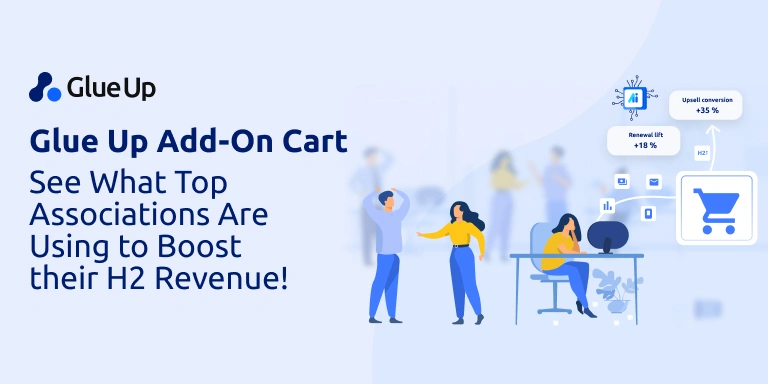
![Advantages Of Paperless Board Meetings [+ Tips] Advantages Of Paperless Board Meetings [+ Tips]](/sites/default/files/styles/all_blogs_block_img_384x192/public/image_1578.png?itok=qnhEtzqs)
